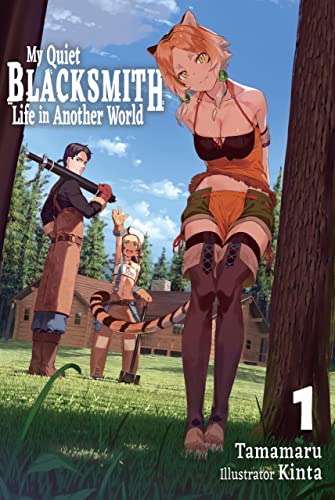By Tamamaru and Kinta. Released in Japan as “Kajiya de Hajimeru Isekai Slow Life” by Kadokawa Books. Released in North America by J-Novel Club. Translated by Linda Liu.
Obviously one should not read too much into the life of the author from the work they are writing. But sometimes it can be pretty easy to see that the creator is a little bit older than most light novel creators. Especially these days, where Truck-kun has been going after beleaguered office workers rather than shut-in high school NEETs. There’s a lack of gaming terminology and dungeon crawling. The harem, if there is one (there usually is) tends to be more familial than horny, at least on the part of the lead. And, of course, despite having super amazing powers and the ability to save the world, our protagonist wants to do nothing but relax and putter around the house doing what they love best. This is all very well and good. In this book, it turns out what the protagonist (and the author) love best is DIY. You will be reading about making swords and knives. You will be reading about building additions to houses. You will be reading this a LOT.
The setup is cookie-cutter. Our hero, Eizo, dies after saving a cat (but not himself) from a truck while on his way home from his crippling IT job. Turns out the cat was a goddess, and that it was not Eizo’s time to die. To try to salvage this, the goddess sends Eizo to a fantasy world, 10 years or so younger than he was (so about thirty). Eizo wants to be able to create things, so he gets knowledge of blacksmithing and the like, as well as some self-defense skills and magic. And then he’s dumped by a cabin in a forest. He wastes no time setting up shop, and quickly gains two companions: Samya, a beastgirl that he saves after she was savaged by a bear, and Rike, a dwarf who sees his handiwork and demands that she become his disciple. Because yeah, turns out he’s not just a normal blacksmith, he’s The Best There Is.
The edges of this book are interesting. There’s a prologue and an epilogue taking place many years after the main events that play this as “the creation of legends”, complete with a hero vs. demon lord scenario, that I found worked really well. We get two side-stories at the end that show the POV of other characters, and it’s interesting, particularly Helen, who is introduced to us (from Eizo’s POV) as something of a meathead swordswoman, but who turns out to be far more serious and practical when we get inside her own head. Unfortunately (and this is a common problem with slow life books) most of the book is from Eizo’s POV, and Christ, he’s dull. Show, don’t tell is left to die at the side of a ditch here, as we get page after page of him making swords, making knives, doing woodworking, chopping trees, all of which goes on forever. Even the fight near the end, where he takes on a massive bear, is fairly tedious as fights go.
As I said, there’s the hint of a good story around the edges of the book. I may read the second volume. But I think the author would be better off getting into woodworking and metallurgy themselves rather than have their creation tell us about it in excruciating detail.
